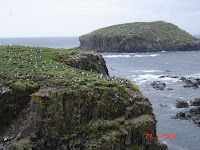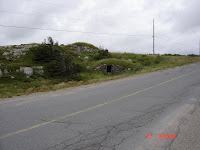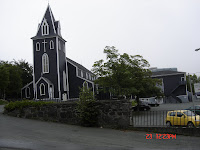
Our first stop after getting off the ferry was
Louisbourg, Nova
Scotia. It is located in the northeast part of the province, in the Cape Breton area. It is a national historic site of Canada--a fortified seaport settled by the French in 1720. If you click on the picture and make it bigger you can see it in the distance.

These buildings are recreations of what was here in 1744. It is quite a history lesson as they have people dressed in costume acting out real people who lived at the fortress. They have a
childrens program where they can become children of the fortress and learn the games and life at that time. This picture is of some of the children in costume.

More of the buildings--in the right corner is the building where the baker of the fortress worked. He baked for the garrison of around 700 and for the civilian population of about 2500. The civilians would bring their bread mixed and he would bake it. There was more that one baker in the fortress.

The governor's house as well as the church and sleeping quarters of the garrison were in this building. The metal horse in front was a means of punishment for the soldiers. The soldiers would straddle the horse and have weights tied on their ankles. They would then sit there for hours.

This is the front gate of the Fortress of
Louisbourg. It was occupied by French until 1745 when New
Englanders and British Royal Navy captured it. They were there until 1749 when it was given back to the French. They were there until 1758 when the British again captured it. The British abandoned it in 1768 where it fell into ruin. Canada has rebuilt a small portion of it. It is still an active
archaeological site.
 Benny is playing music with two of our neighbors in the campground. The fiddle player was junior Canadian champion one year. He now teaches fiddle and judges competitions. Needless to say they all had a great time. Some people in the campground even stopped by to listen to the music.
Benny is playing music with two of our neighbors in the campground. The fiddle player was junior Canadian champion one year. He now teaches fiddle and judges competitions. Needless to say they all had a great time. Some people in the campground even stopped by to listen to the music. The reason we came to this area was to attend the Kintyre Farm Scottish Concert in Judique, NS. This is an area known as the Ceilidh Trail--known for its Celtic music. In this picture there is a fiddle player, guitar player, and piano player. It was great music.
The reason we came to this area was to attend the Kintyre Farm Scottish Concert in Judique, NS. This is an area known as the Ceilidh Trail--known for its Celtic music. In this picture there is a fiddle player, guitar player, and piano player. It was great music.



















































